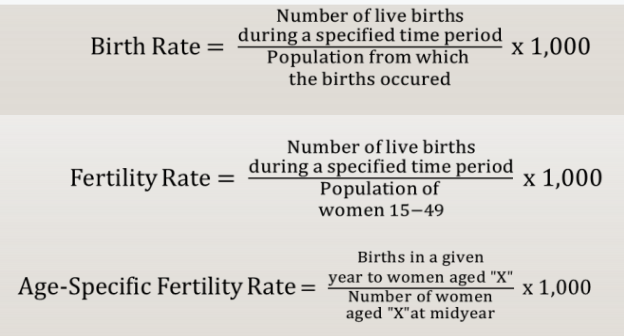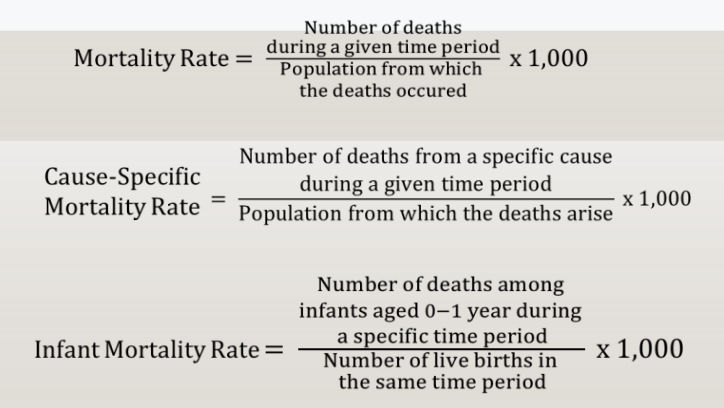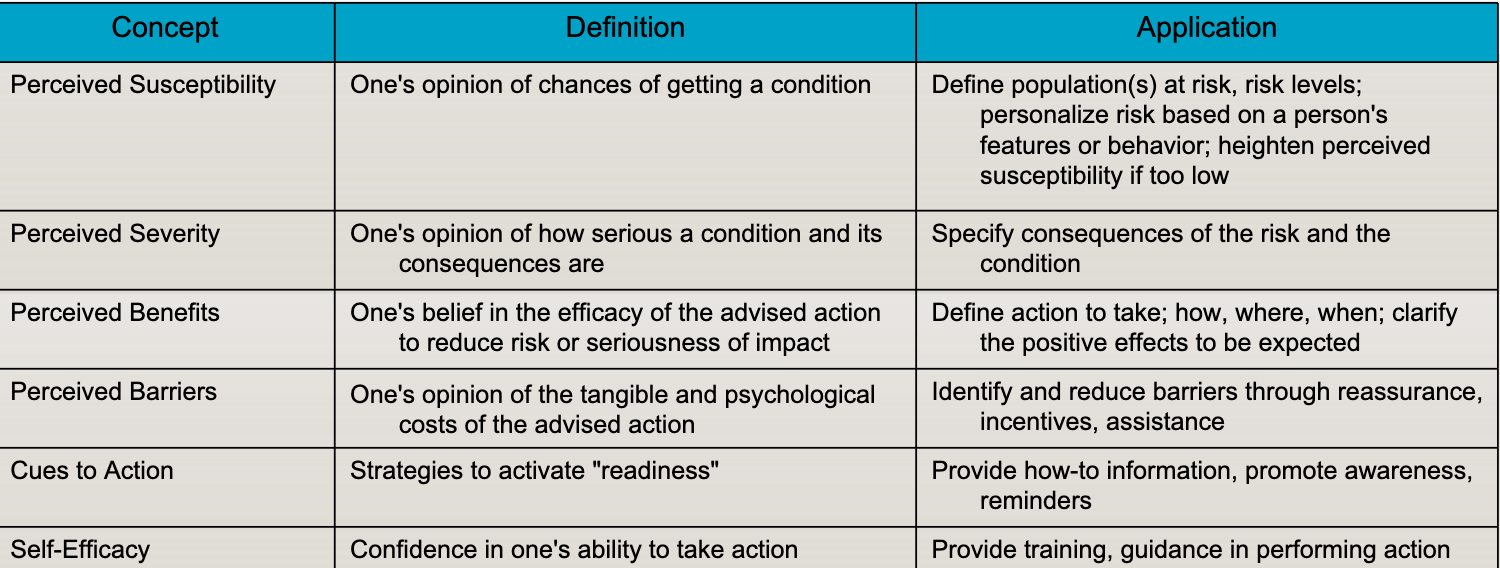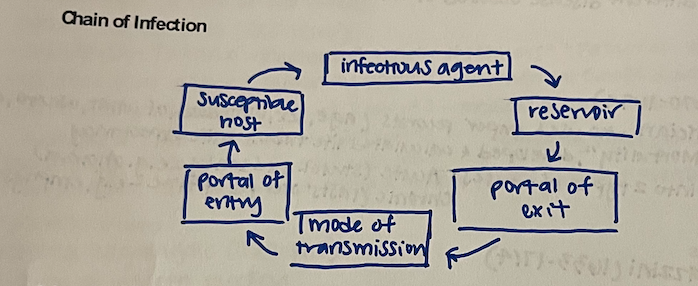HAP 355 Midterm
Chapter 1 - Introduction to Epidemiology
What is epidemiology?
study and analysis of the distribution, patterns, and determinants of health & disease conditions in a defined population
Descriptive Epidemiology
involves characterizations of the distribution of health-related states or events (person, place, time)
Analytic Epidemiology
involves finding & quantifying associations, testing hypotheses, & identifying causes of health-related states or events
Efficacy
ability of a program to produce a desired effect among participants in the program compared to those not in the program
Effectiveness
ability of a program to produce benefits among those who are offered the program
Epidemics
illness or behavior or health-related event in excess of normal
Endemics
ongoing, usual, or constant presence of a disease in a community
Pandemics
epidemic that affects the population of an extensive region
Common-source
specific source
Propagated
infections that are transmitted from one infested person to another
Case
a person in a population who has a disease, disorder, injury, or condition
Case defined
a standard set of criteria
Primary case
first disease case in the population
Index case
first disease brought to the attention of an epidemiologist
Secondary case
person infected after contact with a primary case
Suspect case
individuals or groups who have signs and symptoms but are not diagnosed
Case severity
how disabling or debilitating the illness is (hospital length of stay)
Epidemiology Triangle
Fomite
inanimate object that can harbor a pathogen and is capable of being a means of transmission
Vector
invertebrate animal that transmits infection by conveying the pathogen from one host to another
Reservoir
habitat in which the agent normally lives, grows, & multiplies
Vehicle
a fomite intermediary that conveys the infectious agent from its reservoir to a susceptible host
Carrier
contains, spreads, or harbors an infectious organism
active carrier
exposed and harbors the pathogen
convalescent carrier
harbors the pathogen, the recovery phase
healthy (passive) carrier
not all, but exposed and harbors the pathogen
incubatory carrier
exposed and harbors the pathogen, ability to transmit
time from infection to illness onset
intermittent carrier
exposed to and harbors, can spread pathogen
similar to continuous but it happens at multiple peaks
Direct
un-interrupted and immediate transfer from person to person
Indirect
airborne, vector-borne, and vehicle-borne
Airborne
occurs when droplets or dust carry the pathogen to the host and cause infection
Vector-borne
occurs when an arthropod coveys the infectious agent
Vehicle-borne
involves an inanimate object that conveys an infection from the host
Chain of Infection
Advanced Model Triangle of Epidemiology
Levels of Prevention
primary, secondary, and tertiary
Primary prevention
preventing diseases or disorders before they happen
secondary prevention
aimed at the health screening and detection activities used to identify disease
Tertiary prevention
limiting any disability by providing rehabilitation when a disease, injury, or disorder has already occurred
Chapter 2 - Historic Developments in Epidemiology
The First Epidemiologist
Hippocrates (460-377 BC)
Physicians, with a rational perspective rather than a supernatural take on diseases, introduced terms like epidemic and endemic and observed that different diseases occurred in different locations (malaria and yellow fever)
Vital Statistics
John Graunt (1620-1674)
English statistician who used paper records (age, sex, who died, of what, where, and when) aka “Bills of Mortality”, developed and calculated life tables and life expectancy
Divided death into 2 types of causes: acute and chronic
Acute
struck suddenly — e.g., cholera
Chronic
lasts’ over a period of time — e.g., emphysema)
The Disease of Workers
Bernardino Ramazinni (1633-1714)
professor of medicine who observed disease among workers arose from two causes: the harmful character of materials workers handled and unnatural postures imposed upon the body during work
Sailors and scurvy
James Lind (1716-1794)
Scottish naval surgeon observed the effect of time, place, weather, & diet on the spread of disease
scurvy occurs after 4-6 wks. at sea, the experimental study was set up with sailors sick with scurvy (12 sailors into 6 groups) — two men were given lemons and oranges, and after 6 days, they were fit for duty, since 1895 The British navy required limes and lime juice to be included in their diet
Smooth as a Milkmaid’s Skin
Benjamin Jesty (mid 1700s) was a farmer and dairyman who noticed that milkmaids never got smallpox, he exposed his wife and kids to cowpox to protect them from smallpox and it worked
Edward Jenner (1799-1823) was an English rural physician who also noticed that dairymen and milkmaids got cowpox and not smallpox — inoculated an 8 yo boy, James Phipps with Sarah Nelms fresh cowpox legion and later inoculated the same boy with a fresh smallpox lesion to which no disease developed
Broad Street Pump
John Snow (1813-1858)
English physician (father of Epidemiology) who studied cholera by identifying incubation times, length of time from infection until death, modes of transmission of cholera, and disease mitigation
Later in career he conducted 2 major investigative studies (1) descriptive epidemiologic investigation in which he compared death rates of cholera to where people got their water (3 water companies)
Childbed “A Tale of Two Words”
Ignaz Semmelweis (1818-1865)
Hungarian Physician - Obstetrics “Savior of Mothers” and “Father of Hand Hygiene” discovered the classic “wash your hands” after concluding that childbed fever which plagued maternity hospitals throughout Europe was due to the lack of hand hygiene from medical students who carried infection from dissecting room
Lady with the Lamp
Florence Nightingale (1820-1910) mother of modern nursing
War of Crimea called FN to care for soldiers in Constantinople - Scutari Hospital
Nightingale School of Nursing (1st School of Nursing) and Notes of Nursing
Baaaaa
Louis Pasteur (1822-1895)
French chemist, microbiologist, physician who became confident to take on anthrax
unclear why bacteria identified as anthrax caused disease as it was present on dead sheep — discovered that anthrax spores were brought to the surface via earthworms and created a vaccine & proved it worked in an experimental study
Typhoid Mary
Marry Mallon (early 1900s) is an Irish chef
typhoid fever causes hemorrhage from the inside
George Soper found live typhoid virus in Marry Malloy who had been asymptomatic
Chapter 3 - Practical Disease Concepts in Epidemiology
Communicable disease
infectious diseases that are contagious, or capable of being communicated or transmitted
Non-communicable disease
a disease not transmissible directly from one person to another
Vertical Transmission
from an individual to its offspring through sperm, placenta, milk, or vaginal fluid
Horizontal Transmission
infectious agents from an infected person into a susceptible person
Characteristics of infectious disease agents
viability, communicability, infectivity, pathogenicity, and virulence
Viability
ability of the infectious agent to survive outside the host and to exist or thrive in the environment
Communicability
ability of the infectious disease to be transmitted from one person not the next, or spread into a population
Infectivity
ability of an infectious agent to cause infection; measured as the proportion of persons exposed to an infectious agent who became infected
Pathogenicity
ability of an infectious agent to cause disease after infection; measured as the proportion of persons infected by an agent who then experience clinical disease
Virulence
ability of an infectious agent to cause severe disease; measured as the proportion of persons with the disease who become severely ill
Stages of Disease
1) Susceptibility 2) Pre-symptomatic Disease 3) Clinical Disease 4) Recovery, Disability, or Death

How the Human Body Resists Infection
General resistance or immunity (active or passive)
Active Immunity
the body produces its antibodies against a specific invading substance called an antigen, which offers permanent immunity
naturally or artificially acquired active immunity
Passive Immunity
involves the transfer of antibodies to one person produced by another person, short-lived (wks. to most.) immunity
naturally or artificially acquired passive immunity
Herd immunity
the notion that if the herd (population or group) is mostly protected from disease by immunity, the chance that a major epidemic occurs is limited
Communicable Disease and Prevention and Control
prevention and control of infectious and contagious diseases are the foundation of all PH measures
how we control communicable diseases: remove, eliminate, or contain the cause or source of infection; disrupt and block the chain of disease transmission; protect the susceptible population against infection and disease
Environmental Control
clean water, safer air, pasteurized milk, safe food, management of solid waste, control of vectors (insects and rodents)
Host-related Control
quarantine applies to persons who become exposed to a contagious disease, may or may not be ill
isolation applies to people who are known not to be ill with contagious diseases
Infection-control and prevention
personal hygiene and antibiotic prophylaxis
Chapter 4 - Descriptive Epidemiology
Describes the extent of a public health problem according to person, place, and time
communicate a PH problem with the use of tables and graphs
identify who is at greatest risk for health-related events or states
understand how descriptive epidemiology can provide clues as the causes of diseases
descriptive epidemiology is the notion of public health surveillance
Types of Descriptive Study Designs
Ecologic Study – associations on a population level
Case Study/Case Series – description of a problem or situation for an individual or group
Cross-sectional – examines associations among health-related states or events and personal characteristics, there is no follow-up period.
Types of Data
Nominal – gender, race, marital status, occupation
Ordinal – stage of cancer
Discrete – new cases of breast cancer reported in US in a given year, number of sick days taken, number of children a family has. Think “counting”
Continuous – height, weight, age, temperature. Think “measurement”
Person
answers the WHO question
descriptions often include: age, sex, race or ethnicity, marital and family status, occupation, education
Age
has a strong influence on outcomes and findings in studies, thus needs to be considered; if necessary, controlled for in the analysis
Population pyramids
are used to track and compare changes in the population age distributions over time
Stationary pyramid
a population pyramid typical of countries with average fertility and low mortality, very similar to a constructive pyramid
Expansive pyramid
a population pyramid that is very wide at the base, indicating high birth and death rates
Constrictive pyramid
a population pyramid that comes in at the bottom
the population is generally older on average, as the country has a long life expectancy and allows a death rate, but also a low birth rate

Gender or Sex
sex is biologically founded, while gender is a socially constructed notion
Place
descriptive data by place addresses the WHERE question
data often involve comparisons between or among geographic locations, in groups before and after migration, and between twins in different settings
Time
epidemiologic investigations range from hours to years or years to decards
short-term disease incubation periods of a. few hours can be as important to the epidemiologist as long-term latency periods for chronic diseases, spanning decards
temporal is another term occasionally used to describe time factors, time-related elements, or issues
Time trends
examples: temperature measured at noon each day, number of hospital admissions per day
Point source epidemic
individual exposed to the same source over a limited time period
shown by a clustering of cases in time with a sharp increase and trailing decline
Continuous source epidemic
exposure is continuous over time
shown by a gradual increase, plateau, and then decrease
Epidemic curve
looks like a spike in the graph during the span of time
Types of time trends
secular, short-term, cydic, seasonal
Secular
represent long-term changes in health-related states or events
Short-term
usually brief, unexpected increases in health-relate events or states
Cydic
represent periodic increases and decreases in the occurrence of health-related states or events
Seasonal
represent periodic increases and decreases in the occurrence, interval, or frequency of disease. Tend to be predictable
Seasonal time trend
represent periodic increases and decreases in the occurrence, interval, or frequency of diseases; tends to be predictable
Surveillance — two types:
medical and public health
What is public health surveillance?
communicable diseases, injuries, birth defects, chronic diseases, and health behaviors
Why surveillance data?
the systematic ongoing collection, analysis, interpretation, and dissemination of health data
monitor: to identify sudden changes in occurrence, follow long-term trends and patterns, and identify changes in risk factors
as a result, we identify whether: Does a health problem exist? Is the problem getting worse?
Health programs may be aimed at
increasing vaccination levels, reducing smoking, increasing fruit and vegetable consumption, increasing physical activity, decreasing obesity, and increasing screening
What determines the values of a surveillance program?
appropriate actions have been taken to date as a result of information from the surveillance system, information has been used to make decisions and take action, monitored prevalence of outcome variable relates to the level and distribution of services available, information may be used in the future
Final thoughts on descriptive epidemiology
confounding factors are always a threat in descriptive studies, analytic epidemiologic studies are better for minimizing the threat of confounding, and descriptive studies are a good first step in the search for causes of health-related states or events
Chapter 6 General Health and Mortality
life expectancy: the number of years an individual is likely to live
1,000 will change due to how many are in the region


Chapter 11 Chronic Disease Epidemiology
Noninfectious acute conditions
things that happen suddenly; e.g., car accident, injury,
Noninfectious chronic disease
characterized by a latency period of 10 to 20 or more years; e.g., heart disease, cancer (typically), diabetes
Chronic disease epidemiology involves the study of the distribution and determinants of chronic disease and conditions in the human population and the application of the study for
preventing and controlling chronic health problems
William Farr
promoted the idea that some diseases, especially chronic diseases, have a multifactorial etiology (set of causes)
A risk factor is a variable associated with an increased probability of experiencing an adverse health outcome
The Environment and Chronic Health Problems:
physical
chemical
biological
social factors that influence the health status of these people
Physical stresses and health
temperature, radiation, chemicals, toxins, vehicular issues, climate change, and many more
Exposure to radiation has three basic pathways
Inhalation: breathing radioactive materials into the lungs
Ingestion: swallowing radioactive material
Direct: external exposure
Toxicokinetics
Absorption: entrance of the substance into the body
Distribution: movement of the substance from where it enters the body to other sites in the body such as liver, blood and lymph circulation, kidney, and lungs
Biotransformation: transformation produced by the body of the substance into new chemicals
Excretion: ejection of the substance or metabolites from the body
The Social Environment and Health
War: mental and physical disabilities
Families and household: dietary behaviors
Social networks and social supports: foster the ability to deal with and survive chronic health problems
Neighborhoods and communities: may include environments that facilitate [physical activity, which in turn reduces the risk of certain chronic conditions
Public health policy: may reduce exposure to individuals of risk factors for certain chronic diseases
Behavior and Chronic Health Problems
Many of the diseases and conditions today are influenced by the lifestyles of modern populations
career pressures, sedentary lifestyles, high-density population living, poor diet, crime, drugs, gangs, poverty, pollution, fear, stress, and economic struggles
Smoking and chronic disease
Cancer
Diet and chronic disease
huge link between diet and cancer - 35% of all cancer is attributed to diet
modifying one’s diet can reduce the risk of some cancers and protect against other types of cancer
Osteoporosis: one out of every two women over the age of 50 years will have an osteoporosis-related fracture
Body weight and chronic disease
several health complications associated with excessive weight
high blood pressure, stroke, heart disease, diabetes mellitus, osteoarthritis, impaired functioning of the heart and lungs, gallbladder disease, hyperlipidemia, obstructive sleep apnea, injuries, cancer
Sexual practice and chronic disease
being sexually active - as opposed to abstaining from or postponing sexual activity
having many sexual partners - either serially or concurrently
practicing unprotected sex - which includes the irregular or incorrect use of condoms
health consequences: sexually transmitted infection, HIV and AIDS, cervical cancer
Heredity and chronic health problems
10-20% influence of heredity plays into getting cancer
Risk factors of breast cancer
risk increases with age
family history of breast cancer (explains 5-10% of cases) many risk factors such as geography, exposure to radiation, obesity, not breastfeeding, having first child at a late age
mammography is the most effective method of screening
treatable if detected early
Selected Prevention Behaviors
maintaining a healthy weight, eating no more than two or three servings of red meat per week, taking a multivitamin, eating less than one alcoholic drink, eating five or more servings of fruits and veggies per day, eating more high-fiber foods such as grains, include cruciferous veggies, not smoking, getting sleep, protection from sun, avoid workplace exposures, protect self from sexually transmitted infections, and exercise regularly
Health Belief Model
perceived susceptibility: one’s opinion of chances of getting a condition
perceived severity: one’s opinion of how serious a condition and its consequences are
perceived benefits: one’s belief in the efficacy of the advised action to reduce risk or seriousness of impact
perceived barriers: one’s opinion of the tangible and psychological costs of the advice action
cues to action: strategies to activate “readiness”
self-efficacy: confidence in one’s ability to take action

Prevention and Control
shift from infectious acute disease to noninfectious chronic diseases in the US, public health prevention and control efforts have also changed emphasis
as risk factors for disease are identified and the extent of these risk factors made known through epidemiologic study, the potential for effective prevention and control efforts exists
prevention and control of noninfectious diseases and conditions is often much more complicated than that of infectious diseases
prevention programs need to be specifically tailored to given societies, cultures, and health determinants
provides the greatest potential for minimizing public suffering and healthcare costs
Priorities in Disease Prevention and Control
(1) great impact on life
(2) suffering from exposures
(3) susceptible populations likely to respond
(4) which communities are most likely to respond
(5) other diseases to be investigated, overlooked, or not being responded
(6) which would yield the greatest improved health states, social impact, and economic benefit
(7) priority for an epidemiological investigation


